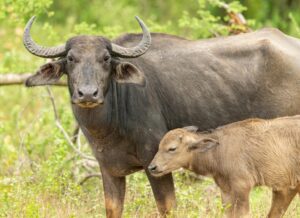Enhancing Fertility in Superovulated Buffaloes
 Water buffaloes (Bubalus bubalis) play a crucial role in global agriculture, particularly in regions where they serve as primary sources of milk, meat, and labor. However, buffaloes exhibit unique reproductive challenges compared to traditional Western livestock such as cows. These include irregular estrous cycles and lower embryo recovery rates, complicating breeding programs. Advancements in reproductive technologies are essential for improving fertility outcomes in these animals.
Water buffaloes (Bubalus bubalis) play a crucial role in global agriculture, particularly in regions where they serve as primary sources of milk, meat, and labor. However, buffaloes exhibit unique reproductive challenges compared to traditional Western livestock such as cows. These include irregular estrous cycles and lower embryo recovery rates, complicating breeding programs. Advancements in reproductive technologies are essential for improving fertility outcomes in these animals.
Reproductive efficiency is a critical factor in livestock management, influencing both productivity and sustainability. Prostaglandins, particularly 13,14-dihydro-15-keto-prostaglandin F2-alpha (PGFM), are vital in regulating reproductive processes such as ovulation, embryo implantation, and uterine function. Monitoring PGFM levels provides key insights into hormonal changes that impact fertility and pregnancy outcomes, making it a valuable biomarker in various domesticated species.
A study published in Theriogenology examined the impact of prostaglandin F2-alpha (PGF2α) administration on fertilization rates in superovulated buffaloes during the periovulatory period. The research aimed to improve embryo recovery rates, one of the longstanding challenges in buffalo reproductive management.
The success of this study highlights the importance of precise biomarker quantification in reproductive research. The Arbor Assays PGFM ELISA Kit (K022-H) enabled researchers to monitor circulating prostaglandin levels, resulting in the correlation of hormonal changes with fertility outcomes.
Arbor Assays’ ELISA kits provide a cost-effective, sensitive, and reproducible method for detecting key reproductive biomarkers across different species. In global livestock production, these tools support:
- Improved fertility protocols for cattle, buffaloes, and other livestock.
- Enhanced embryo transfer success rates in assisted reproduction programs.
- Better pregnancy monitoring and early detection of reproductive inefficiencies.
Measuring Testosterone in Wildlife: White-Tailed Deer
 The study explored how testosterone levels correlate with sexually selected traits, such as antler size and body size, in white-tailed deer (Odocoileus virginianus). Using Arbor Assays’ Testosterone ELISA Kit, researchers analyzed serum testosterone concentrations from deer in a controlled, freely breeding population over a ten-year period. The kit enabled accurate and reliable hormone quantification, supporting a long-term analysis of testosterone’s impact on reproduction and physical characteristics.
The study explored how testosterone levels correlate with sexually selected traits, such as antler size and body size, in white-tailed deer (Odocoileus virginianus). Using Arbor Assays’ Testosterone ELISA Kit, researchers analyzed serum testosterone concentrations from deer in a controlled, freely breeding population over a ten-year period. The kit enabled accurate and reliable hormone quantification, supporting a long-term analysis of testosterone’s impact on reproduction and physical characteristics.
Understanding how hormones influence behavior and reproduction is essential for wildlife and ecological studies. Testosterone, a critical androgen, drives many primary and secondary sexual traits and behaviors across species. A recent study by Gomes et al., published in Evolutionary Ecology, exemplifies how Arbor Assays’Testosterone ELISA Kit (K032-H) is helping to advance research in this area.
Arbor Assays’ Testosterone ELISA Kit (K032-H) was instrumental in these discoveries. Its features include:
- High sensitivity: Testosterone measurement concentrations as low as 9.92 pg/mL, ensuring accurate detection even in low-hormone samples.
- Precision and reliability: The kit provides consistent results across a wide range of samples. These include serum, plasma, TCM, urine, and fecal extracts, enabling robust longitudinal studies.
- Ease of use and support: The researchers used Arbor Assays’Steroid Liquid Sample Extraction Protocol. This protocol offers clear guidance for hormone extraction – one of many easily found on the Arbor Assays website. Here you can also find our comprehensive customer and technical support.
This study highlights the importance of precise hormonal measurements in ecological and behavioral studies and demonstrates the value of integrating Arbor Assays’kits and protocols into your research workflow.
 Attendere..
Attendere..

